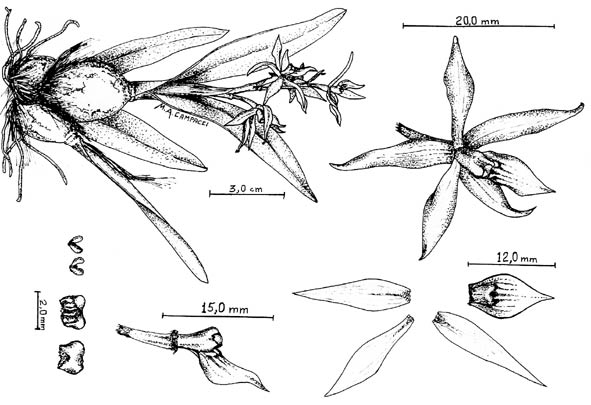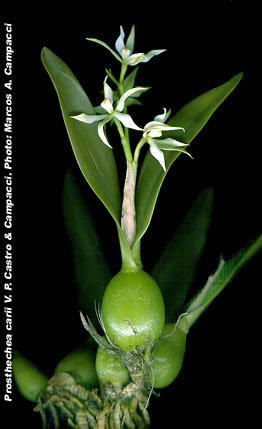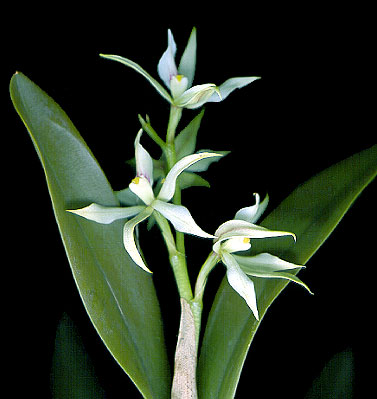 |
||
| Prosthechea carrii V. P. Castro & Campacci sp. Nov. |
 |
|
ABSTRACT: The genus Prosthechea
Knowles & Westcott is a genus, recently resurrected by W. E. Higgins,
for a group of species classified in the genus Encyclia that was
placed in the subgenus Osmophytum in "Orchidaceae Brasilienses"
G. F. J. Pabst & F. Dungs. It deals with a genus very little studied
and with a very wide-spread area of distribution. |
| TIPO: BRASIL: Bahia:
Serra do Sincorá, 1200-1600m de altitude, Março 2000, V.P.Castro
S/N, (HOLOTIPO SP) |
| Specii Prosthechea inversa (Lindl.) W. E. Higgins similis, sed planta minoribus, petalae et sepalae angustae et ¾ magnitudibus, maximus inflorescencia 5cm longi, cun maximus 5 flores. |
 |
| Plant rupicolous Roots white, glabrous Rhizome short Pseudobulbs obovate elongate apex pointed, slightly flattened, initially covered by imbricating deciduous sheaths, 2-3 leaves 3.4 - 4cm long, 2.0 - 2.5cm wide. Leaves narrowly lanceolate up to 9cm long and 2.5cm wide. Inflorescence emerging from the apex of the pseudobulbs, up to 5.0cm long. Floral bracts triangular elongate, acuminate, 3mm long. Flowers floral segments spreading, sepals and petals white with greenish base, lip white with few purple veins near the base, callus white. Dorsal sepal oblong lanceolate, apiculate, slightly sigmoid, shell-shaped, 1.9cm long and 0.4-0.45cm wide. Lateral sepals oblong lanceolate, assymetrical, shell-shaped, apiculate, slightly sigmoid, 2cm long and 0.4-0.45cm wide. Petals oblong lanceolate, narrowed base, apiculate, slightly shell-shaped, pointed upward, 1.8cm long and 0.4-0.45cm wide. Lip entire, lanceolate, basally subrectangular, apically sharply triangular, 1.2-1.3cm long and 0.5-0.6cm wide; callus rounded, perpendicular to the axis of the lip and located close to the base. Column gibbous, not auriculate, middle tooth above the apex of the column, shaped like a fist, truncate, subquadratic with a ligulate projection over the anther; lateral two teeth separated from the middle tooth by the rostellar cavity, 0.6cm long and 0.3cm wide. Anther subquadratic, yellow, two lobed. Pollinarium 4 white pollinia. Stigmatic cavity triangular. |
 |
ETYMOLOGY: Named for Mr. George F. Carr, Jr., specialist on the Genus Cycnoches. This species is found in the Serra do Sincora at an altitude of 1300-1400 meters (4,225 - 4,550 feet) on an isolated flat-topped peak similar to the tepuis of Venezuela or the mesas of the US southwest. The locale is approximately 300 km (180 miles) from the Atlantic Ocean in the Morro do Sol area near the city of Barra da Estiva, Bahia, Brazil. The small size of the plant and the short inflorescence make this a unique species in the genus; we compare it with Prosthechea inversa (Lindl.) W. E. Higgins due to its resemblance to the slightly sigmoid shape of the floral segments, but it differs from the later in its rupicolous growth habit (Prosthechea inversa is epiphytic) and the size of the plant and inflorescence with few flowers (Prosthechea inversa is a plant which reaches 50cm in height and an |
|
inflorescence of up to 25cm in length), a detailed analysis of the floral segments shows that the petals and sepals are different and smaller and the callus on the lip is different. When we compare it with Epidendrum latro Rchb. f. we find the following differences; P. carrii has a short rhizome, the base of the pseudobulb is shaped differently and the pseudobulb is no more than 4cm tall (the pseudobulb of Epidendrum latro is obovate fusiform and up to 8cm tall); leaves erect, rigid, short and broad (Epidendrum latro has arching leaves, long and narrow); spathe long, broad and covering completely the peduncle (Epidendrum latro has a small, narrow spathe covering only the base of the peduncle); peduncle thick, very short approximately 1/5 the length of the leaves (Epidendrum latro has a long, thin peduncle approximately ½ of the length of the leaves); column with middle tooth well-separated from the lateral teeth (Epidendrum latro has the middle tooth almost joined to the lateral teeth); sepals and petals slightly longer and much wider in comparison with those of Epidendrum latro; lip much wider and the apex much more apiculate, stigma triangular (Epidendrum latro is obovate). |
|
Bibliography |
E-mail: vpcastro@terra.com.br E-mail: campacci@sili.com.br |
| Photo: Vitorino Paiva Castro Neto - Illustration: Marcos Antonio Campacci |
back